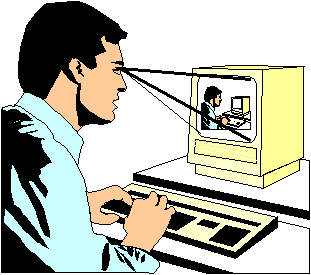

Something physical - light - is emanating from that screen - a source of radiation - which passes over a distance - and thus is "remote" to some extent - until it encounters and is captured by a sensor - your eyes - which then sends a signal to a processor - your brain. The human senses gather their awareness of the external world almost entirely by perceiving a variety of signals, either emitted or reflected, actively or passively, from objects that transmit this information in the form of waves or pulses. Thus, one hears disturbances in the atmosphere carried as sound waves, experiences sensations such as heat (either through direct contact or as radiant energy), reacts to chemical signals from food through taste and smell, is cognizant of certain material properties such as roughness through touch, and recognizes shapes, colors, and relative positions of exterior objects and classes of materials by means of sampling visible light issuing from them. In the previous list, all sensations that are not received through direct contact can be considered to be remotely sensed.
However, in practice we do not usually think of our bodily senses as remote sensors in the way that term is applied in technical usage. A formal and comprehensive definition of applied remote sensing, as it is customarily given, is:
The acquisition and measurement of data/information on some property(ies) of a phenomenon, object, or material by a recording device not in physical, intimate contact with the feature(s) under surveillance; techniques involve amassing knowledge pertinent to environments by measuring force fields, electromagnetic radiation, or acoustic energy employing cameras, lasers, radio frequency receivers, radar systems, sonar, thermal devices, seismographs, magnetometers, gravimeters, scintillometers, and other instruments.
This is a rather lengthy and all-inclusive definition. Perhaps a simplified definition is in order: Remote Sensing is a technology based on sampling radiation and force fields that seeks to acquire and interpret geospatial data to develop information about features, objects, and classes on the Earth's land surface, oceans, and atmosphere (and where applicable on the exterior's of other planets).
Or, try this variation: Remote Sensing involves the detection and measurement of photons of differing energies emanating from distant materials, by which these may be identified and categorized by class/type, substance, and spatial distribution.
All of these statements are valid and, taken together, should give you a reasonable insight into the meaning and use of the phrase or term "Remote Sensing".
(Hereafter, in this Introduction and in the sections that follow, the discussion and the scenes examined will be confined to remote sensing products obtained exclusively by measurements within the electromagnetic spectrum. Primary emphasis is focused on pictures (photos) and images (either TV-like displays on screens or "photos" made from data initially acquired as electronic signals rather than recorded directly on film). We will concentrate mainly on images produced by sensors operating in the visible and near-IR segments of the electromagnetic spectrum (see below) but will inspect as well a few images obtained by radar and thermal sensors.)
Code 935, Goddard Space Flight Center, NASA
Written by: Nicholas M. Short, Sr. email: nmshort@epix.net
and
Jon Robinson email: Jon.W.Robinson.1@gsfc.nasa.gov
Webmaster: Bill Dickinson Jr. email: rstwebmaster@gsti.com
Web Production: Christiane Robinson, Terri Ho and Nannette Fekete
Updated: 1999.03.15.